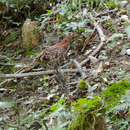ar
الأسماء في صفحات التنقل



The copper pheasant or Soemmerring's pheasant (Syrmaticus soemmerringii) is endemic to Japan. The scientific name commemorates the German scientist Samuel Thomas von Sömmerring.
It is a large pheasant with a rich coppery chestnut plumage, yellowish bill, brown iris and red facial skin. The female is a brown bird with greyish brown upperparts and buff barred dark brown below. The male has short spurs on its grey legs, while the female has none. He measures 87.5–136 cm (34.5–54 in) long including the tail, while the female measures 51–54 cm (20–21 in) (subspecies scintillating copper pheasant, scintillans) including the tail.[2]
The copper pheasant is distributed in and endemic to the hill and mountain forests of Honshū, Kyūshū and Shikoku islands of Japan, where it is known as yamadori (山鳥). The diet consists mainly of insects, arthropods, roots, leaves and grains. Due to ongoing habitat loss, limited range and overhunting in some areas, the copper pheasant is evaluated as Near Threatened on the IUCN Red List of Threatened Species.
Five subspecies of Copper pheasant are generally recognized, which become progressively darker further south in its distribution:
The copper pheasant appears in Japanese poetry as far back as poetry composed by Kakinomoto no Hitomaro in the early 8th century, as compiled in the Hyakunin Isshu:[3]
Ashibiki no yamadori no wo no shidari-wo no naga-nagashi yo wo hitori ka mo nemu
Must I sleep alone through the long autumn nights, long like the dragging tail of the mountain pheasant separated from his dove?
 Specimen – AMNH
Specimen – AMNH The copper pheasant or Soemmerring's pheasant (Syrmaticus soemmerringii) is endemic to Japan. The scientific name commemorates the German scientist Samuel Thomas von Sömmerring.